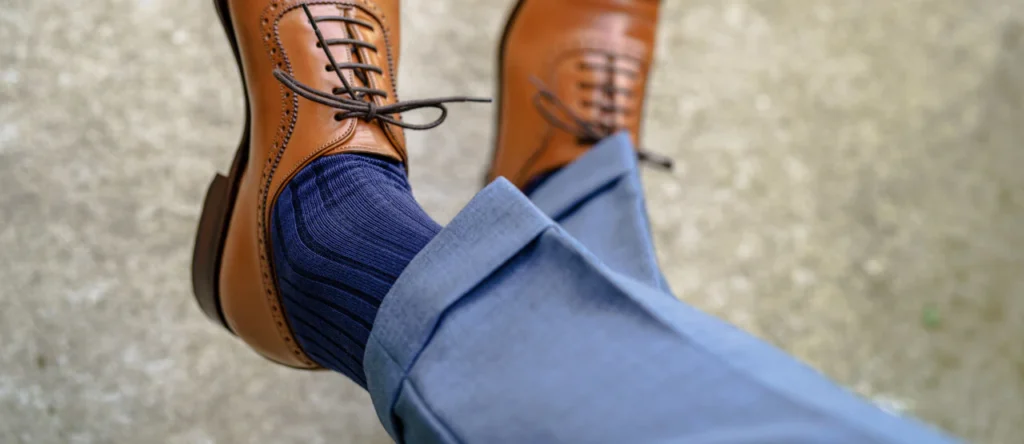Brown Shoes With Blue Pants
Our fashion critic talks about how dress standards have changed over time and how some laws, like the one that forbids wearing brown shoes with blue or black pants, might become popular and then disappear.
During the past two years, guys have been wearing brown shoes with black or blue slacks. I believed that this was prohibited by a rule. Should the new tendency be stopped, and how did it begin?
One guideline that my banking friends would frequently repeat to me throughout my twelve years in London was “No brown in town,” which means no brown shoes at work. This concept dates back to the Victorian era, when men would march over the vales of their country estates on weekends to hunt and engage in other activities. They would wear brown boots and shoes to match the brown muck.

In order to maintain the uninterrupted line of their suits and to indicate their white-collar position, they changed their brown shoes for polished black ones that matched their belts and shoes when they returned to their offices during the week. Since other countries, particularly the French and Italians, never adhered to the same dress code, the presence of brown shoes in town thus became a statement about both class and nationality.
However, like the majority of previous dress rules, this one has essentially been abandoned due to the casual Friday-ization of daily life and the decline of the suit and tie. The fact that your shoes don’t match isn’t as significant as the fact that your jacket and pants no longer match. Actually, that makes some sense, particularly if you want to convey a laid-back atmosphere.
Brown shoes can appear less stunning and more established when compared to the sneaker’s ascent as a dress shoe, and not just the sneaker but the bizarre Frankenstein sneaker as well.
As I write this, the men’s wear shows are taking place in Paris, so I thought I would ask Jacob Gallagher, our man on the scene, what he is seeing.
He replied, “A lot of what once would have been a ‘wrong’ pairing.” such as brown shoes, blue chinos, and black overcoats. These combinations aren’t particularly gaudy, but they make you look twice, therefore they’re now acceptable.
As he noted, “dressing in once verboten color schemes is a tidier way to look interesting than chucking on a panda backpack or a puffy the shape of mutant rigatoni.” This is because so many dress code guidelines are currently being broken. (By the way, he had just seen those possibilities; they weren’t theoretical.)
Jacob also attributed the breakdown to social media, pointing out that guidelines such as “Don’t wear brown shoes with black pants” are essentially a recipe for the Instagram generation. An “eight slide post about why ‘off’ color combos are actually great because they draw attention” is essentially required since they are an establishment provocation, he claimed.
That’s why even the smallest decisions, like wearing brown shoes with blue jeans, are noticeable. Most likely, someone will notice and make a comment. Thus, you must be ready.
At the same time, the previously unexpected color choice will become less noticeable the more individuals choose change. It may appear perplexing because the mix is now winning the balance. However, it’s never a terrible thing to be free to choose your own shoes, even if those choices are a little startling.
One of our men’s fashion experts, Guy Trebay, claims that there is only one footwear rule that is still relevant today: “Black for evening, worn with matching or complementary socks.” It’s as stale as day-old sprezzatura to wear bare ankles.
Speaking of socks, I’ll address that problem at a later date.
Hello, I am Natasha Rose. I am the founder of the website Best Running Shoes. I am from California, USA. I am a professional shoe analyzer and an employee in a shoe showroom. I like to provide information about all types of shoes.